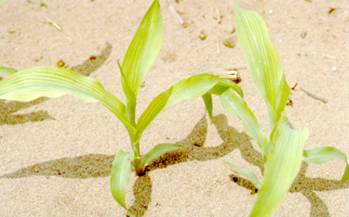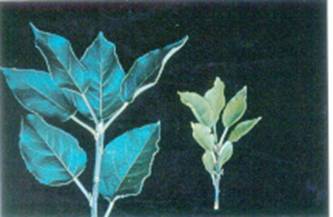1087 Jamison Rd
Washington Court House, OH 43160
(800) 321-1562

Most soil sources of S are in the organic matter and are therefore concentrated in the topsoil or plow layer. Elemental S and other forms as found in soil organic matter and some fertilizers, are not available to crops. They must be converted to the sulfate (SO4- -) form to become available to the crop. This conversion is performed by soil microbes and therefore requires soil conditions that are warm, moist, and well drained to proceed rapidly. The sulfate form of S is an anion (negative charge), and therefore is leachable. As a rough rule-of-thumb, it can be considered to leach through the soil profile at about 50% as fast as nitrates (NO3-). In soils with a significant and restrictive clay layer in the sub-soil, it is common to find that sulfate which has leached through the soil over time and become “perched” on the clay layer. This SO4- -is available to crops when the roots reach this area of the soil.
Sulfur is essential for many plant functions. Some of them are
Other reasons for Sulfur shortages to occur are: (1) strict air pollution standards have cleaned the air of gaseous sulfur compounds, and (2) Sulfur is not present in sufficient quantities in today's higher-analysis fertilizers. As with nitrogen, sulfur can be converted into unavailable forms, lost as a gas, or leached in irrigation or rain water. Excess sulfur does not normally present an agronomic problem for crops, so the conditions listed below do not necessarily indicate a need for corrective measures.
Some people will recommend that sulfur be applied in a particular ratio with N. The origin of this concept appears to be based on an N:S ratio found in protein. While it is entirely possible that many crop producers will get a yield response from applying N and S together, this does not prove that a particular N:S ratio from fertilizer is desirable. Using this approach to recommending sulfur applications is not based on sound agronomic principles and data. For example, it completely ignores the S that is naturally available from the soil. Also, it assumes that both the applied N and S will be taken up in the same amounts that they were applied (thus retaining this “ideal” ratio). If the crop takes up N and S in a particular ratio, the dominant controlling factors will not be the ratio of these elements applied as fertilizer. The very complex soil chemistry, microbiology, as well as variable crop, culture, and environmental factors will inevitably work against the crop absorbing N and S in a particular ratio, simply because that ratio was applied as fertilizer.
While this is an essential element for all plants, these crops have been found to be especially responsive: alfalfa, broccoli, cabbage, canola, cauliflower, celery, corn, sugar beets, sugar cane, table beets, turnips and watermelon.
Sulfur is a necessary constituent in several amino acids and proteins. Since these are building blocks in the plant, Sulfur becomes fixed into the plant's structure. Therefore, the classic symptom of deficiency is a paleness of the younger foliage. However, many times all of the foliage has a pale green color, and the difference in “paleness” between the older and younger foliage is not easily noticed. This can lead to a misdiagnosis of N deficiency for S deficiency (Nitrogen deficiency symptoms appear on the older leaves first.). In some cases, the leaf veins may be lighterin color than the surrounding tissue.
 Corn |
 Apples |
Sulfur toxicity for practical purposes should be considered as non-existent. Excessive applications most often result in a depression of soil pH and an increase of the problems that occur with the pH decrease. In fact, sulfur uptake is reduced as the pH of the soil decreases.
Studies by the Sulfur Institute have demonstrated a definite need in most States. Thus, the agronomic need has already been established and publicized. However, determining if the addition of Sulfur is economically sound for each of your growers fields has not been established. That is what you must determine with individual testing.
Plant analysis is an excellent tool to use for detecting sulfur problems. With it you can identify deficiencies, plus imbalances such as N:S and P:S ratios that may be a problem. Plant analysis is also useful if used to determine if enough sulfur is being taken up from soils shown to be borderline or low in the soil analysis results.
Correcting problems with Sulfur is usually not difficult but it is better to avoid situations where problems could be created.
| Recommended rates of S | |
|---|---|
| Method | Rate |
| Broadcast | 10 to 30 lb./A |
| In row (2×2) | 5 to 15 lb./A |
| Foliar | 1.0 to 1.5 lb./A |
Most crops require both a soil and a plant analysis to verify an actual need. However, be concerned if visible symptoms are evident, since this indicates serious yield reductions have already occurred. Also you must remember, as growers strive for those exceptional yields, the need for Sulfur will increase proportionally.
| Some Sulfur containing Fertilizer Products | ||
|---|---|---|
| Product | Chemical Formula | Typical Sulfur Content |
| Aluminum Sulfate | Al2(SO4)3 | 14.4% |
| Ammonium Sulfate | (NH4)2SO4 | 24% |
| Ammonium ThioSulfate | NH4S2O3 | 26% |
| Calcium Sulfate | CaSO4 | 15-17% |
| Epsom Salts | MgSO4·7H2O | 14% |
| Ferrous Sulfate | FeSO4 | 12% |
| Potassium Sulfate | K2SO4 | 17.5% |
| K-Mag | KMgSO4 | 22% |
| Elemental Sulfur (Bentonite) | S | 90% |
| Sulfuric Acid | H2SO4 | 32% |